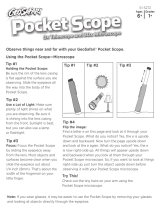
1
2
Welcome to the Microscopic World
Welcome to the hidden world of the microscope. Your new microscope is an
instrument with lenses for making very small objects appear much larger so
they can be studied. There are millions of tiny living plants and animals that can
be easily seen with your microscope.
In today’s technological world, every field of science utilizes microscopes.
Microscopes are used by biologists for studying microorganisms, by geologists
for studying rocks and minerals, by archaeologists for studying ancient artifacts,
and by astronomers for studying fallen meteorites.
Your microscope set contains the following parts:
1 – Die-cast Metal Microscope
1 – 10X Eyepiece
1 – 20X Eyepiece
1 – Scalpel
1 – Spatula
1 – Stirring Rod
1 – Tweezers
1 – Test Tube with Cap
1 – Petri Dish
1 – Pipette
3 – Specimen Vials
3 – Prepared Slides
8 – Blank Slides
8 – Slide Labels
16 – Slide Covers
Instruction and Activity Guide
What are all of these things for?
a) Microscope – The microscope holds samples of very small things on
clear slides. It shines a bright light through the small sample, and then
lenses make the sample look very big. Your microscope can make things
look 50 times, 100 times, 150 times, 300 times, or even 600 times larger
than the way you see them with your own eyes.
b) Eyepieces – These eyepieces are special magnifying lenses that work
with your microscope’s other lenses.
c) Scalpel – A scalpel is a sharp blade used to cut very thin pieces of
material so you can look at them with your microscope.
d) Spatula - The spatula has a large flat blade, but it is not as sharp as the
scalpel. The spatula is used for scraping off bits of material for testing and
to mash and flatten soft samples.
e) Stirring Rod – Use this rod to mix fluids until they are well blended. An
example is when you mix salt and water.
f) Tweezers – The tweezers are used to pick up small specimens and to handle
samples that you don’t want to touch with your hands – like slimy mold!
g) Test Tube with Cap – This thin, clear tube, used to hold liquid samples,
makes it easy to observe if anything is happening, such as when a
sample changes color.
h) Petri Dish – This round, flat dish with a clear cover is used to grow and
observe samples, such as molds.
i) Pipette – This is a plastic device that you can dip into a liquid to transfer
drops to a slide for examination.
j) Specimen Vials – These are little plastic bottles with tight fitting lids. They
are used to carry your samples from where you collected them to where
you have your microscope set up.
k) Prepared Slides – These slides have samples on them that have been
prepared by professionals for you to examine.
l) Blank Slides – These are the clear slides that you will place prepared
samples on for examination under your microscope.
m) Slide Labels – These are little pieces of paper with sticky backs. You can
write on them and stick them on your slides to record information such as
when the sample was prepared.
n) Slide Covers – These are little squares made of thin, clear plastic. They
are used to cover very small samples on a slide. See the instructions in
this guide for making temporary and permanent slides.

























